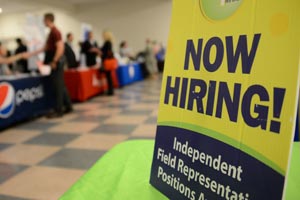Record Job Openings Bolster Optimism About Economy

The U.S. labor market has tilted sharply toward job hunters as unfilled openings hit a record high in May, reinforcing signs of corporate optimism about the economy’s prospects.
The number of vacancies rose to 5.36 million, the most since records began in 2000, from a revised 5.33 million in April, a report from the Labor Department showed July 7. For the second time ever, openings at companies exceeded hiring.
With job listings rising and dismissals waning, employers may have to offer higher wages to lure more skilled workers. The report, which includes some metrics tracked by Federal Reserve Chair Janet Yellen, augments her view that the employment outlook is improving though some weakness remains.
“This is good news on the economic front,” said Millan Mulraine, deputy head of U.S. research and strategy at TD Securities in New York, who forecast 5.3 million openings. “There’s willingness to hire, but companies are having difficulty finding the right person. Wages could start rising.”
The tightening of the labor market indicates companies are upbeat about U.S. demand in the face of weaker global markets. A report July 7 from the Commerce Department showed American businesses were having trouble drumming up overseas sales.
The U.S. trade deficit widened 2.9% to $41.9 billion in May as exports declined by the most in three months. While persistent household spending led to record purchases of foreign-made autos during the month, domestic oil production helped keep total imports in check. America’s imported fuel bill declined to the lowest level since February 2002, according to the report.
“The U.S. economy is doing better than the global economy,” said Gus Faucher, an economist at PNC Financial Services Group Inc. in Pittsburgh. “Trade is going to be a drag, but the domestic economy is strong enough that the U.S. economy will continue to grow at an above-trend pace.”
Stocks rose, after the Standard & Poor’s 500 Index rebounded from a drop below its average price during the past 200 days, as speculation grew that Greece’s crisis would be contained. The S&P 500 climbed 0.6% to 2,081.34 at the close in New York.
The increase in job openings was led by more listings at professional and business services, retailers and restaurants.
The median forecast in a Bloomberg survey of economists projected 5.3 million openings in May after a previously reported 5.38 million a month earlier. The Labor Department began keeping records in December 2000.
The Job Openings and Labor Turnover Survey, or JOLTS, adds context to monthly payroll data by measuring dynamics such as resignations, help-wanted ads and the pace of hiring. Although it lags the Labor Department’s other jobs figures by a month, Yellen follows the report as a measure of labor-market tightness and worker confidence.
The latest figures indicate there are about 1.6 unemployed people vying for every opening, compared with about 1.8 when the 18-month recession began in December 2007.
Some 2.7 million people quit their jobs in May, little changed from the prior month. The quit rate, which shows the willingness of workers to leave their jobs, held at 1.9%and compares with a 2% reading when the recession started at the end of 2007.
Total dismissals, which exclude retirements and those who left their jobs voluntarily, decreased to 1.65 million from 1.78 million a month before.
The number of people hired was little changed at 5 million, while the hiring rate eased to 3.5% from 3.6%. The gauge calculates the number of hires during the month divided by the number who worked or received pay during that period.
In the 12 months ended in May, the economy created a net 2.8 million jobs, representing 60.2 million hires and 57.4 million separations.
The JOLTS data follow the June payroll report, which showed jobs are being created without a marked increase in wages. The United States added 223,000 workers last month, and the jobless rate fell to a seven-year low of 5.3%. At the same time, average hourly earnings at private employers rose 2% over the 12 months ended in June, matching the average gain in the current expansion.
The progress in the labor market is among the reasons Fed policymakers are considering starting to raise the benchmark interest rate from near zero. Yellen also has said she expects the first rate increase in 2015 and that subsequent increases will be gradual.

